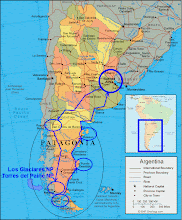Cueva de Los Manos to Perito Moreno Parque Nacional WE HAVE NOW
WE HAVE NOW driven hundreds and hundreds of miles on Ruta 40’s ripio (rubble road); and after three days of the jarring, noisy, bumpy, slow-speed torture I think it’s starting to get to Bobbie … she keeps unloading and reloading her 38 Magnum pistol, looking around kinda wild-eyed, and then shooting out the window at the weird, saucer-shaped clouds hovering over the endless landscape, hoping “to puncture one so it will zip all over the sky!”
OK, I made that up – we don’t have any weapons – it is me whom the ripio is getting to.
After a week and half we’ve developed a schedule – today’s is as typical as any:
4 AM: Bill goes outside to visit the bushes (the porta-toilet is a hassle and we’re out on the Patagonian steppe by ourselves). It’s cold but tolerable with a slight breeze. Although there’s a moon the stars are still spectacular, but very unfamiliar: no Big Dipper, North Star, etc.
7 AM: Still dark but we’re up. Coffee, cold cereal, etc. Use body wipes in place of a shower.
8 AM: On the road
9 AM:
Cueva de los Manos (Cave of the Hands) about 30 miles off Ruta 40 … well developed UNESCO World Heritage site, but very isolated. We’re the only two there for the 9 AM tour, so we get a personal perspective of the 9,000 year-old self-paintings of their hands by nomadic hunters. The guide – a young woman who also speaks some English – is very interesting. She refuses to take a tip but does accept a bottle of wine from us.

10.30 AM: On the road.
11AM: Back on Ruta 40, but stopped in the dusty pueblo of Bajo Caracoles, will be the last opportunity to fuel up for at least a day.
1 PM: Lunch on Ruta 40. Stop in the middle of the road – there is no traffic and it’s very wide. Sit on a rock, eat, and admire the vastness.
2 PM. Cross wind is extremely strong … we’re sailing all over the road … feels like I’m going to fly the upwind two wheels of the truck.
3 PM. Turn off of Ruta 40 to go to
Perito Merino National Park. We’ve read that it’s a beautiful park and that there is a great tourist estancia in the park – thinking maybe we’ll sleep in a regular bed and have a regular bathroom for one night, possibly go horseback riding in the morning. Ripio road to the park is better than Ruta 40, looking at snow capped Andes the whole way.
4.30 PM. At the park entrance. Road goes from gravel to hell – either mud holes or washboard.
5 PM Get to the park Hdqtrs, Bill talks with Ranger lady, finds out the tourist estancia is open and gets directions. The park is very undeveloped but looks great –mountains shooting for the sky, beautiful valleys, glacial lakes, the whole picture.
6 PM: At the tourist estancia, looking pretty run down, reality starts creeping in. Take a tour and find out it will cost $105 US DOLLARS – not pesos – for us to stay one night – very expensive. Plus, it looks and smells like grandma’s house. We’re outta there.
7 PM: We’ve driven to the park’s official camping ground about 20 miles away. Much more mud, truck now looks like we’ve gone thru the 24 hours of Baja. Site is beautiful on a glacial lake with mountains screaming up on either side, trees all around in fall colors, but there is no latrine, the wind is howling, and the temperature dropping rapidly. This won’t work either.
8.30 PM: Back at the park hdqtrs, camping by the bathrooms. Rangers OK with it. Dark, cold, and windy.
9 PM: Happy Hour – rum and diet cokes. Bill types a few notes on the computer.
9.30 PM: Dinner – corn with a canned Argentine meal that looks a little like corned beef hash. Very good. Yogurt and canned peaches for desert.
10 PM: Watch a DVD that we brought to Argentina of the TV show “Homicide” on the laptop until the battery dies near the end of the episode. We won’t know who the killer is until after we charge up the computer battery while driving tomorrow.
11 PM. Go to bed. Have to turn off the camper heater so no concern about carbon monoxide. Wind is very strong and rocks the camper, but it knocks us right out.
 Bobbie and Bill at Cueva de Los Manos. More pictures here.
Bobbie and Bill at Cueva de Los Manos. More pictures here.Entrance to Perito Moreno National Park














































 10.30 AM: On the road.
10.30 AM: On the road.




